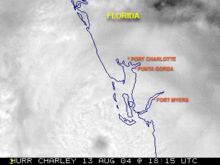
Charlotte County is a U.S. county located in southwestern Florida. As of the 2020 census, the population was 186,847. Its county seat is Punta Gorda.

Charlotte Harbor is a census-designated place (CDP) in Charlotte County, Florida, United States. The name Charlotte Harbor also refers to Charlotte Harbor (estuary) and Charlotte Harbor Preserve State Park, a 42,000-acre (17,000 ha) preserve with 70 miles (110 km) of shoreline along Charlotte Harbor in Charlotte County.
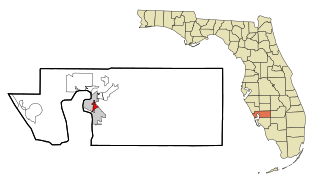
Charlotte Park is a census-designated place (CDP) in Charlotte County, Florida, United States. The population was 2,667 at the 2020 census, up from 2,325 at the 2010 census. It is part of the Punta Gorda, Florida Metropolitan Statistical Area, included in the North Port-Bradenton, Florida Combined Statistical Area.

Cleveland is a census-designated place (CDP) in Charlotte County, Florida, United States. The population was 3,435 at the 2020 census, up from 2,990 at the 2010 census. It is part of the Punta Gorda, FL Metropolitan Statistical Area, part of the North Port-Bradenton, Florida Combined Statistical Area.

Englewood is a census-designated place (CDP) in Charlotte and Sarasota counties in the U.S. state of Florida. As of the 2020 census, it had a population of 20,800, up from 14,863 at the 2010 census. It is part of the North Port-Bradenton-Sarasota, Florida Metropolitan Statistical Area.

Grove City is an unincorporated community and census-designated place (CDP) in Charlotte County, Florida, United States. The population was 2,174 at the 2020 census, up from 1,804 at the 2010 census. It is part of the Punta Gorda, FL Metropolitan Statistical Area, included in the North Port-Bradenton, Florida Combined Statistical Area.

Harbour Heights is a census-designated place (CDP) in Charlotte County, Florida, United States. The population was 3,428 at the 2020 census, up from 2,987 at the 2010 census. It is part of the Punta Gorda, Florida Metropolitan Statistical Area, included in the North Port-Bradenton, Florida Combined Statistical Area.
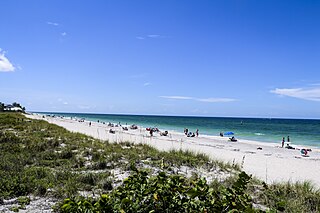
Manasota Key is a census-designated place (CDP) consisting mainly of the community of Englewood Beach in Charlotte County, Florida, United States. The population of the CDP was 1,326 at the 2020 census, up from 1,229 at the 2010 census. It is part of the Punta Gorda, Florida Metropolitan Statistical Area, included in the North Port-Bradenton, Florida Combined Statistical Area.

Rotonda West is an unincorporated, deed-restricted planned community situated in Charlotte County, Florida, United States. The 2020 U.S. Census Bureau lists it as the Rotonda census-designated place, with a population of 10,114, up from 8,759 at the 2010 census. It is part of the Punta Gorda, Florida Metropolitan Statistical Area, included in the North Port-Bradenton, Florida Combined Statistical Area. It was developed and named Rotonda West by Cavanagh Communities Corporation, which purchased the land in 1969.

Solana is an unincorporated community and census-designated place (CDP) in Charlotte County, Florida, United States. The population was 671 at the 2020 census, down from 742 at the 2010 census. It is part of the Punta Gorda, Florida Metropolitan Statistical Area, included in the North Port-Bradenton, Florida Combined Statistical Area.

Arcadia is a city and county seat of DeSoto County, Florida, United States. Arcadia's Historic District is listed on the National Register of Historic Places. Its population was 7,420 as of the 2020 census, down from 7,637 at the 2010 census. It is the principal city of the Arcadia, Florida Micropolitan Statistical Area.
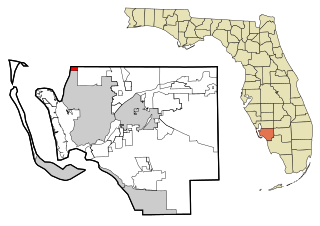
Burnt Store Marina is an unincorporated community and census-designated place (CDP) in Lee County, Florida, United States. The population was 1,890 at the 2020 census, up from 1,793 at the 2010 census. It is part of the Cape Coral-Fort Myers, Florida Metropolitan Statistical Area.

Punta Rassa is an unincorporated community and census-designated place (CDP) in Lee County, Florida, United States. The population was 1,620 at the 2020 census, down from 1,750 at the 2010 census. It is part of the Cape Coral-Fort Myers, Florida Metropolitan Statistical Area.

Kendall is an unincorporated area and census-designated place in Miami-Dade County, Florida. It is part of the Miami metropolitan area of South Florida. At the 2020 census, the area had a population of 80,241.

Westchester is a census-designated place (CDP) and neighborhood in Miami-Dade County, Florida. It is part of the Miami metropolitan area of South Florida. Prior to the 2020 U.S. Census, the neighboring University Park CDP was merged into Westchester CDP, effectively doubling its geography and population. Per the 2020 census, the population was 56,384.

North Port is a city located in Sarasota County, Florida, United States. The population was 74,793 at the 2020 US Census,, up from 57,357 at the 2010 US Census. It is a principal city in the North Port–Bradenton–Sarasota, Florida Metropolitan Statistical Area.
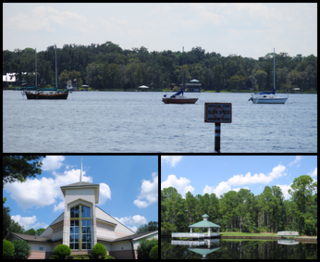
Fruit Cove is a census-designated place (CDP) in St. Johns County, Florida, United States. It is located in the community of St. Johns. The population was 32,143 at the 2020 census, up from 29,362 at the 2010 census. It is part of the Jacksonville, Florida Metropolitan Statistical Area.

Charlotte County Public Schools (CCPS) operates all public K-12 schools in Charlotte County, Florida. It covers Port Charlotte, Punta Gorda, Englewood, Rotonda West, Babcock Ranch, and surrounding areas. It operates ten elementary schools, four middle schools, three high schools, and six specialty education centers.

Deep Creek is a deed restricted unincorporated community in Charlotte County, Florida, United States. It lies 5.5 miles (8.9 km) East of Port Charlotte. The community is part of the Sarasota-Bradenton-Punta Gorda Combined Statistical Area. Deep Creek is served by utilities of both Punta Gorda and Port Charlotte. Deep Creek's mail is processed at the Punta Gorda post office, but telephone numbers in the area are registered as Port Charlotte.
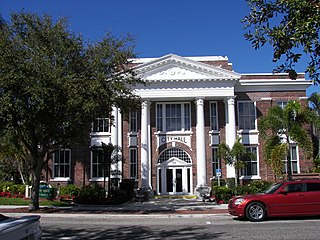
Punta Gorda is a city located in Southwest Florida and is the county seat of Charlotte County, Florida, United States. As of the 2020 U.S. Census the city had a population of 19,471, up from 16,641 at the 2010 census. Punta Gorda is the principal city of the Punta Gorda, Florida Metropolitan Statistical Area, part of the North Port-Bradenton Florida Combined Statistical Area.

